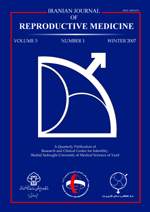
|
International Journal of Reproductive BioMedicine
Research and Clinical Center for Infertility, Shahid Sadoughi University of Medical Sciences of Yazd
ISSN: 1680-6433
EISSN: 1680-6433
Vol. 17, No. 2, 2019, pp. 135-142
|
 Bioline Code: rm19015
Bioline Code: rm19015
Full paper language: English
Document type: Case Report
Document available free of charge
|
|
|
International Journal of Reproductive BioMedicine, Vol. 17, No. 2, 2019, pp. 135-142
| en |
Trans-arterial embolization of acquired uterine arteriovenous malformation after Cesarean section: A case series
Harzif, Achmad Kemal; Haloho, Agrifa; Silvia, Melisa; Pratama, Gita; Purwosunu, Yuditiya; Wibawa, Aria; Sidipratomo, Prijo & Pandelaki, Jacub
Abstract
Background: Acquired uterine arteriovenous malformation (AVM) is a rare condition
due to traumatic episodes in cesarean section. The patient can suffer from life-threatening
hemorrhage or recurrent vaginal bleeding. Establishing this diagnosis is
difficult, often misdiagnosed due to lack of information and number of cases. Trans-Arterial Embolization (TAE) procedure is rarely performed in our center. All of the
cases were found with history of massive bleeding and diagnosed lately after recurrent
bleeding history. Even though promising, one of our cases failed to be managed with
TAE. It is important to diagnose early symptoms of AVM in order to prevent the life
threatening event.
Case presentation: In these case series, four cases of AVMs after cesarean procedures
will be reviewed. One could be diagnosed in less than a month but the other three took
several months. The symptom of vaginal bleeding might occur a few weeks after the
procedure is done, and most patients need transfusion and hospitalization. Three out of
four patients were initially sent to the hospital in order to recover from shock condition,
and one patient was sent for a diagnostic procedure. AVMs diagnostic was established
with ultrasound with or without angiography. Three of our cases were succeeded by
performing TAE procedure without further severe vaginal bleeding. One case failed to
be treated with embolization and had to proceed with hysterectomy.
Conclusion: AVM should be considered early-on in patient with abnormal uterine
bleeding and history of cesarean section. Embolization is still the first-choice treatment
of AVMs, otherwise definitive treatment is hysterectomy in a patient without fertility
need, or impossible to perform TAE.
Keywords
Trans-arterial embolization; Acquired uterine arteriovenous malformation; Cesarean section.
|
| |
© Copyright 2019 - Achmad Kemal Harzif et al.
Alternative site location: http://www.ijrm.ir
|
|
